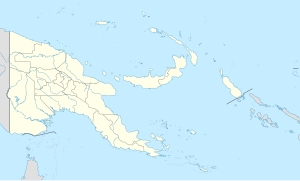Buka, Bougainville
This article needs additional citations for verification. (January 2019) |
Buka | |
|---|---|
Town | |
 Buka Township, with Sohano Island (Bottom left) and Buka Airport | |
| Coordinates: 5°25′19″S 154°40′22″E / 5.42194°S 154.67278°E | |
| Country | Template:Country data Autonomous Region of Bougainville |
| Province | Bougainville Province |
| District | North Bougainville District |
| Time zone | UTC+10 (AEST) |
| Main languages | Nasioi, Rorovana |
| Climate | Af |
Buka is located on the southern coast of Buka Island, in the Autonomous Region of Bougainville, in eastern Papua New Guinea (country).[1] It is administered under Buka Rural LLG.[2]
It is the capital of the North Bougainville District, and the interim provincial capital of the Autonomous Region of Bougainville.
It contains Our Lady of the Assumption Cathedral.[3]
Geography
The city and Buka Island are separated from the northern tip of Bougainville Island by the Buka Passage. Both islands are in the northern Solomon Islands archipelago, and the only major ones not within the nation of Solomon Islands. The city is served by Buka Airport. From the way that it is separated by the deep, the narrow Buka Passage, which displays a range of about 980 to 3,000 feet (300 to 1,070 metres) wide. With Bougainville and several islands groups, it forms the autonomous region of Bougainville. A volcanic formation which measures 35 miles by 9 miles (56km by 14km), Buka has a total land area of 190 square miles (492 square km). With the island being able to rise to 1,634 feet (498 metres) in hills on the southwest, the island is densely forested in the interior.[1] Rainfall is abundant, with more than, with more than 100 inches (2,500 mm) annually. Coral reefs fringe the south and west coasts, the latter deeply indented by Queen Carola Harbour.
Buka consists of three major geological units: a plateau of uplifted coral reefs, steep hills and coral formations of post-Pleistocene age.[4]
History
Discovered in 1768[5], Buka became the capital of the Bougainville Province decades later, during the 1990s Bougainville Civil War. The former, or "proper" capital of Bougainville, Arawa, was all but destroyed in 1990 as tensions reached a critical level in a civil uprising, which ended in 1997.[citation needed] The Bougainville government intends to return the capital to Arawa in the future.[6]
See also
References
- ^ a b "Buka Island | island, Papua New Guinea". Encyclopedia Britannica. Retrieved 14 April 2019.
- ^ United Nations in Papua New Guinea (2018). "Papua New Guinea Village Coordinates Lookup". Humanitarian Data Exchange. 1.31.9.
- ^ "Our Lady of the Assumption Cathedral". GCatholic. Retrieved 2019-04-13.
- ^ Specht, Jim (July 1974). "Of Menak and Men: Trade and the Distribution of Resources on Buka Island, Papua New Guinea". Ethnology. 13 (3): 225–237. doi:10.2307/3773164. JSTOR 3773164.
- ^ McAlpine, J. R.; Saunders, J. C.; Speight, J. G.; Heyligers, P. C.; Scott, R. M. (2010). "No. 20 Lands of Bougainville and Buka Islands, Territory of Papua and New Guinea". CSIRO Land Research Surveys. 2010 (1): 1–196. doi:10.1071/lrs20 (inactive 2019-08-20).
{{cite journal}}: CS1 maint: DOI inactive as of August 2019 (link) - ^ The Report: Papua New Guinea 2016. Oxford Business Group. 2016. p. 52. ISBN 978-1-910068-64-9.
- Connell, John (2017). "Environmental Refugees? A tale of two resettlement projects in coastal Papua New Guinea". Australian Geographer. 48: 79–95. doi:10.1080/00049182.2016.1267603.

